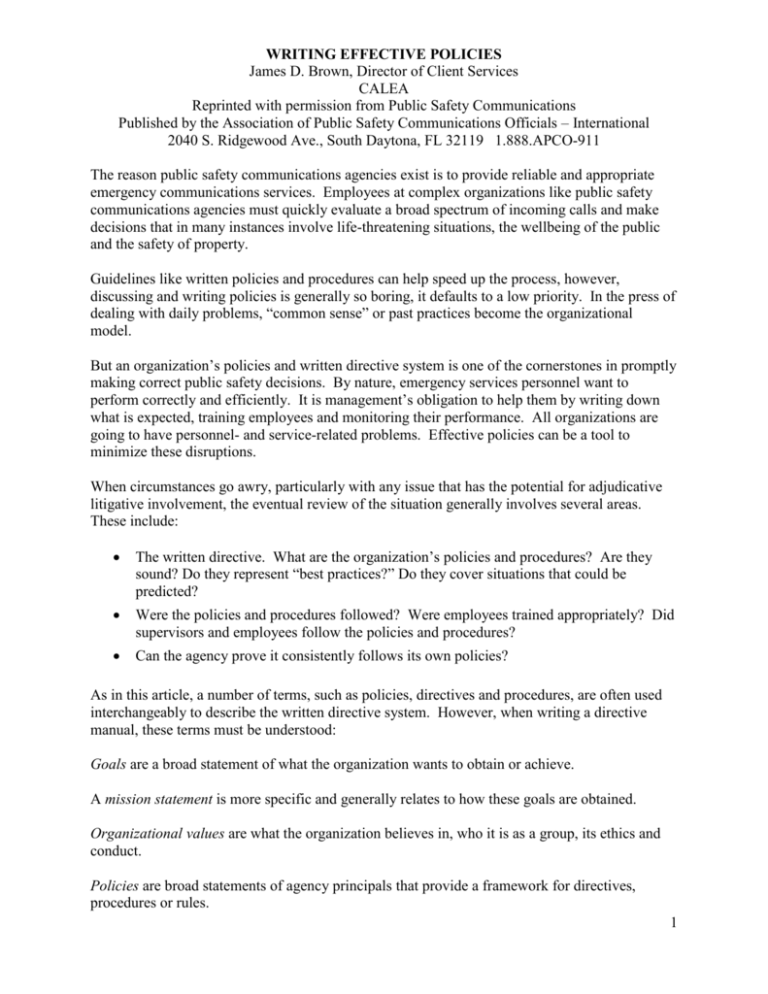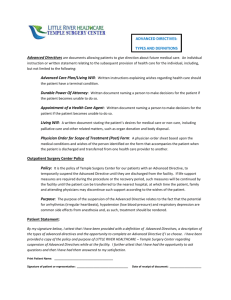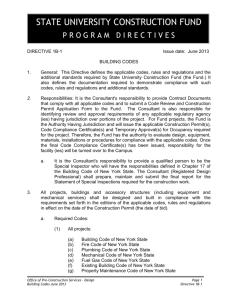writing effective policies
advertisement

WRITING EFFECTIVE POLICIES James D. Brown, Director of Client Services CALEA Reprinted with permission from Public Safety Communications Published by the Association of Public Safety Communications Officials – International 2040 S. Ridgewood Ave., South Daytona, FL 32119 1.888.APCO-911 The reason public safety communications agencies exist is to provide reliable and appropriate emergency communications services. Employees at complex organizations like public safety communications agencies must quickly evaluate a broad spectrum of incoming calls and make decisions that in many instances involve life-threatening situations, the wellbeing of the public and the safety of property. Guidelines like written policies and procedures can help speed up the process, however, discussing and writing policies is generally so boring, it defaults to a low priority. In the press of dealing with daily problems, “common sense” or past practices become the organizational model. But an organization’s policies and written directive system is one of the cornerstones in promptly making correct public safety decisions. By nature, emergency services personnel want to perform correctly and efficiently. It is management’s obligation to help them by writing down what is expected, training employees and monitoring their performance. All organizations are going to have personnel- and service-related problems. Effective policies can be a tool to minimize these disruptions. When circumstances go awry, particularly with any issue that has the potential for adjudicative litigative involvement, the eventual review of the situation generally involves several areas. These include: The written directive. What are the organization’s policies and procedures? Are they sound? Do they represent “best practices?” Do they cover situations that could be predicted? Were the policies and procedures followed? Were employees trained appropriately? Did supervisors and employees follow the policies and procedures? Can the agency prove it consistently follows its own policies? As in this article, a number of terms, such as policies, directives and procedures, are often used interchangeably to describe the written directive system. However, when writing a directive manual, these terms must be understood: Goals are a broad statement of what the organization wants to obtain or achieve. A mission statement is more specific and generally relates to how these goals are obtained. Organizational values are what the organization believes in, who it is as a group, its ethics and conduct. Policies are broad statements of agency principals that provide a framework for directives, procedures or rules. 1 Directives are specific written instructions or information that are generally topical. Procedures are step-by-step actions to consider or take depending on specific situations. “Always verify a 9-1-1 caller’s name and address, even if it is on the ALI screen” is an example of a procedure. A memo is a method of communicating information on a specific issue. Special instructions provide instructions for temporary or unusual situations. Reviews are supervisory checks of employee actions or work products to ensure they meet the organization’s standards. An analysis is a critical review of all the relevant available information, with logical conclusions deduced from the compilation. A plan is a method of accomplishing something or responding to a situation in the future. Each term represents a directive systems device used to affect the organization’s culture and services provided. While these definitions provide basic guidance in structuring a directive system, it is more important the written directives are appropriate and employees understand the directives. Employee involvement in policy and directive development is recommended, as it contributes to employees “buying into” the organization’s culture or to changing the culture. Equally important is employees have good ideas to improve both the organization and the written directive system. Here are three groups of considerations that will be helpful in developing a policy or directive system. General Considerations A well-done comprehensive policy and procedures project can be a formidable task, accomplished one detail at a time. Make the directive system work for your organization. For example, if “directives” are too authoritarian, call them “policies.” Establish requirements for compliance with policies and an acknowledgement process, so you know policies were read and understood. In drafting directives, consider factors such as: What is the organization really doing? What should it be doing? What is the agency doing that is not written down? What should be changed? What is missing? When the answer to a question of procedure is. “Because we have always done it that way.” You have located an area that needs review. Knowledgeable individuals or work groups can write draft policy for the agency’s CEO, but the final drafts should be submitted to all agency personnel for review and comment. Have a plan to deal with procrastinators assisting with policy and directive development. 2 The CEO should take care to express to employees that, while all comments concerning policies will be listened to, only written comments will be officially considered in the review process. Establish a system to review agency policies, directives and procedures periodically, along with agency compliance. The CEO should read the material rewritten until it is adequate, correct and well written. Consider providing materials in a write-protected electronic version, as well as maintaining several hard copies at specific locations. When updating policies, keep old policies as a reference. Obtain legal review of high-liability areas. After directives are reviewed and implemented, provide training to supervisors and employees. CONTENT POINTERS Establish the organization in writing by describing the agency’s goals, mission and values. List the organization’s major functions, what they do and to whom they report. Include an organizational chart. Explain the written directive system: Who issues them? To whom? How do they change? How are they numbered and distributed? How are they integrated with other policies? What is the review system? Consider separate directives or policy chapters for each major organizational activity and area of concern. Some suggested items for consideration include personnel, conditions of employment, training, operations and support services. Some of these areas, like operations, may have a considerable number of detailed procedures in sub-topics such as law enforcement, animal calls, fire, EMS or public utilities. Develop others to the extent they provide value to your organization. FORMAT POINTERS In a comprehensive system, the directive may refer to and briefly summarize supplemental material that already exists. This includes, but is not limited to, labor contracts, the governing body’s rules, insurance and hospitalization information, state laws, manufacturer information and appropriate training material. Use care with some words. A guideline can be appropriate in some instances but can create serious problems in others. Do you want to use “guidelines” to determine when to notify the fire service of a call, or do you want specific procedures followed? Be cautious of words like “must” and “may” or “should” and “shall,” as some have a discretionary aspect to them. Make a table of contents. If there is a lot of material, make a detailed index. The better the index, the more people will use it. Title, number and date all your material. Number pages with the directive number followed by a sequential number (6-1, 6-2, 6-3) to significantly reduce confusion. 3 Print directives by themselves. Running more than one major policy or chapter together makes for an easy first printing, but it is a major waste of time and resources when revisions are issued to individual policies or chapters. Do not use fancy logos and extraneous formats. Avoid government “fluff” writing with its useless extra words. Make the material easy to read and to the point. Make sure the material doesn’t contradict itself in another directive and has the necessary detail to provide guidance. Eliminate partial duplications through consolidating policies and directives. Take care to define special terms and abbreviations, as this reduces later misunderstandings. If necessary, establish a vocabulary. The organization now enters the most difficult area: actual compliance with the directives. First-line supervisors are responsible for ensuring directives are followed, but, at the same time, they may receive significant peer pressure to “go easy” with new policies and procedures. In many instances, it is too easy for experienced personnel to take shortcuts and be successful. It is when the shortcut is not successful that problems occur. To ensure the policy-revision effort is successful, the CEO must ensure policies and procedures are followed. To be effective, the directive system must be flexible and adjusted to incremental changes before the sum of changes causes the directives to be considered inadequate. When incremental changes are needed, they can be introduced into the directive system through the periodic review and update process. If there is an emergency requiring immediate action that deviates from agency directives, handle the emergency and make necessary directive changes as soon as possible. A well-done directive system provides employees with much of the information they need to perform their assignments effectively. This facilitates superior public safety services, our original goal. About the Author James D. Brown is the Associate Director for the Commission on Accreditation for Law Enforcement Agencies (CALEA) APCO and CALEA jointly developed the Public Safety Communications Agency Accreditation Program in 1999. 4




